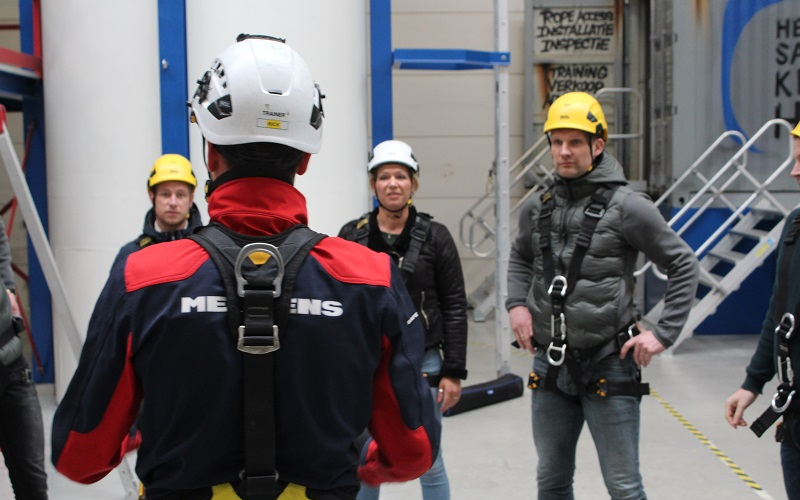
Use of Milan evacuation or rescue equipment: risk without valid certificate
Safety is paramount when working at height: it simply involves risks. That is why you should never work alone. ‘If a colleague falls, the other person must be able to act immediately, and employers are obliged to have an emergency plan in place,’ says Nicky. Calling the emergency services should never be the only emergency plan. In addition, emergency services such as the fire brigade are almost always too late in such situations and often cannot even reach the victim. A standard ladder truck, for example, only reaches about 30 metres. If you are 100 metres up in a wind turbine, you definitely need a different plan.
Rescue and evacuation
This is where the Milan comes in, a centrifugal evacuation and rescue device developed by Skylotec. You should have this compact device with you in situations where you need to rescue a colleague or where you or a colleague needs to escape.
‘The standard Milan has two main functions,’ explains Nicky. ‘You can use it to rescue someone or to evacuate yourself.’ Evacuation is often necessary when a normal route is no longer passable, for example due to fire or smoke. This is particularly relevant in wind turbines or cranes. ‘If the cable lift fails or is unusable, you need another way to get down safely.’
‘When we ask the operator if he knows how it works, the answer is usually no.’
Theory and practice
Fortunately, most professionals who work at height think about carrying a centrifugal evacuation and rescue device such as the Milan with them. But according to Nicky, this is where the procedure often goes wrong. He has often encountered a good example of this among harbour crane operators.
‘They often sit in a small cabin at a great height,’ says Nicky. ‘Behind their seat is an evacuation kit, intended for emergencies such as fire or smoke development. In theory, this is an excellent solution, but in practice, it is different. When we ask the operator if he has ever opened the kit or knows how it works, the answer is usually no.’
Skylotec certified
‘This is precisely the problem: safety equipment is useless if the user does not know how it works. Training ensures that personnel know what to do in emergency situations and are able to carry it out.’
There is no shortage of training courses on working with the Milan in the Netherlands. But, according to Nicky: ‘Officially, only Skylotec-certified parties are allowed to provide training with the Milan. If you look at the number of training courses in the Netherlands and realise that we, Safe Site Powered by Mennens, are one of only two companies that have this certification... well, the conclusion is obvious.’
Certification by the manufacturer is crucial, says Nicky. ‘Suppose a company has used a Milan in an accident. Even if the outcome is positive, there will always be an investigation. If you cannot prove that you have been officially trained by a certified trainer, you have a problem.’
Training and inspection
In addition, these devices are extra sensitive to wear and tear when used in training: they are not designed for frequent use, as is the case in training. Frequent
inspection and maintenance are therefore extra important.
‘We inspect and maintain the Milan in accordance with Skylotec's guidelines, because they trained us. But this is not the case at the vast majority of training centres. I wonder how you can guarantee that your training will run optimally, in terms of equipment use, but also in terms of safety.’
Not only training courses, but also inspections of the Milan may only be carried out in accordance with NEN-EN 365: 2004 by specialists trained by the manufacturers. ‘To inspect a Milan, you must have completed official Skylotec service training,’ says Nicky. ‘Only then will you have access to the necessary spare parts and tools.’
‘They send the system to an inspector, who sticks a sticker on it without looking.’
Sticker
Nicky has a good example of this too: ‘Many companies do have their Milan inspected. But then they send the system to an inspector who sticks a sticker on it without looking any further. Such a device must be opened to perform an inspection. If you don't do that, the inspection is not reliable and safety is not guaranteed.’
‘After opening the Milan's aluminium housing, you must replace the screws with exactly the same, approved screws. You can only order these if you are certified as a service provider. Most inspection services are simply not certified.’
In short: have your staff trained by Skylotec-certified trainers. And have your Skylotec safety systems – such as the Milan – inspected by Skylotec-certified inspectors. ‘This is not an unnecessary luxury,’ concludes Nicky. ‘It is simply necessary to save lives.’





